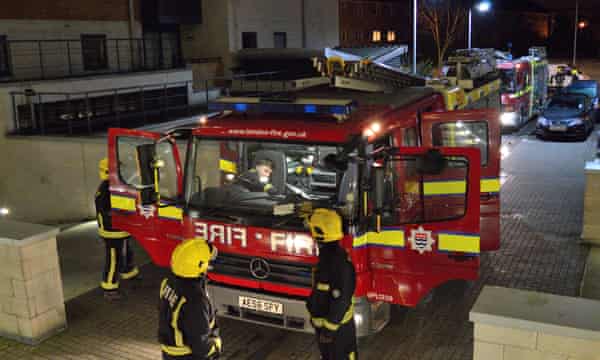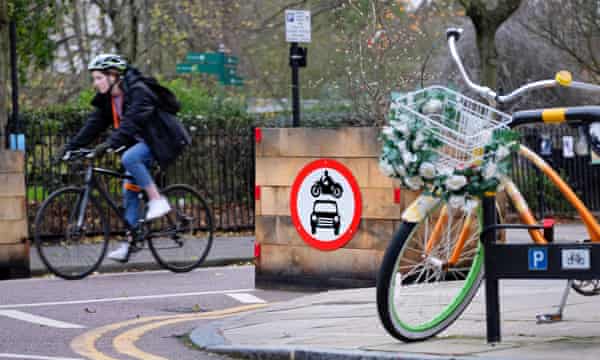If you have been to learn sure newspapers for lengthy sufficient, the message would appear clear: the primary explanation for visitors congestion is measures to spice up strolling and biking – that’s, separated cycle lanes, and so-called low-traffic neighbourhoods, or LTNs.
LTNs, schemes to dissuade by means of visitors on smaller residential streets by filters permeable to folks travelling by foot or cycle, however not by personal motorcar – whether or not camera-enforced or within the bodily type of planters or bollards – are on the centre of a very fierce transport-based tradition conflict.
The common focus for that is entry for emergency autos. Tales about ambulances or fireplace crews supposedly held up by badly carried out or not consulted-on planters are a near-daily staple of some information retailers.
This text is an try and get to the information, and in flip to make use of the row about emergency entry as a microcosm for the broader, and infrequently depressingly poisonous, debate on LTNs. The examples and research cited will, I’m afraid, come from London, given the latest unfold of LTNs within the capital, and the resultant undeniable fact that the analysis tends to be centered there.
One factor is fairly clear: there may be nearly no proof that LTNs routinely, and even recurrently, delay emergency companies. The one correct examine of the phenomenon discovered no delays; neither the London ambulance service (LAS) or London fireplace brigade (LFB) imagine there’s a normal drawback; and the handful of makes an attempt to show a widespread concern disintegrate on examination.
Equally – as a couple of factor may be true directly – that doesn’t imply that there are by no means delays which might be attributable to LTNs. There are some emergency service workers who’ve completely rational complaints about features of how some schemes are carried out.
Analyzing visitors patterns and attributing delays to explicit causes is a massively advanced enterprise, and the problem for supporters of LTNs is that they’re searching for, to an extent, to show a damaging. The burden of proof is arguably extra with the opponents to show there is a matter. And right here, it appears, they’ve failed.

The one particular examine I learn about into the problem, led by public well being tutorial Dr Anna Goodman, and revealed late final 12 months within the journal Transport Findings, appeared into the very particular concern of whether or not LTN schemes within the north-east London borough of Waltham Forest had affected fireplace crews.
The LFB retains detailed information on response instances and the acknowledged causes for any delays. Finding out greater than 23,000 incidents within the borough between 2012 and 2020, the examine discovered no proof that LTNs, after they have been launched – Waltham Forest was an early adopter – slowed crews. On the boundary of the LTNs, in actual fact, response instances truly quickened.
There was, nonetheless, one fascinating phenomenon: the proportion of the delays put all the way down to “visitors calming measures” – the metric that covers LTNs – rose, notably when newer LTNs had been constructed.
The authors argue that this appeared largely all the way down to the tutorial phenomenon often called “salience”: the truth that some issues are simply extra memorable than others. Therefore, a crew having to detour spherical a brand new set of bollards are more likely to notice this of their report than, for instance, being held up by visitors.
The corollary to the Waltham Forest report is a information story within the Occasions final month, which used the intensive LFB information to argue that LTNs did look like an issue, citing the truth that delays attributed to “visitors calming measures” rose way more steeply in boroughs with new LTNs than these with out – by 35% as in opposition to 2.8%.
Whereas superficially notable, the article is just not academically credible, for a number of causes. One is the influence of salience on the outcomes. One other is that London boroughs are huge and complicated locations, and there was no try made to account for the various different components that might be concerned – not least the very totally different visitors patterns of lockdown.
Lastly, the pattern measurement is small. An evaluation by the Bike is Finest marketing campaign appeared on the LFB information and located that “visitors calming measures” was a tiny proportion of the entire variety of recorded delays, ranging between 1.3% and 1.5% lately.
The LFB is fairly clear in its view, saying it backs measures to spice up lively journey, and works carefully with councils over how they’re carried out.

The LAS doesn’t hold equally micro-level response information, and it’s with ambulances, not less than in London, the place the LTN image turns into a bit of extra advanced.
A key a part of that is very primary logistics. Fireplace crews are based mostly at stations, and have a tendency to deal with incidents domestically earlier than returning; as such, their drivers will typically know the streets and routes nicely. In distinction, ambulance crews and paramedics will set off from a base initially of their shift, however are then typically despatched from incident to hospital to incident, and might find yourself kind of wherever throughout the capital.
Because of this, ambulance drivers are way more reliant on navigation methods, which aren’t at all times instantly up to date with new LTN schemes. The LAS has its personal bespoke navigation system, however I’m advised it’s not totally trusted, with drivers typically utilizing apps on their telephones. Some LTNs have camera-enforced filters, by means of which emergency companies can go – but when a crew is counting on, say, Waze or Google Maps, they won’t be directed that manner.
The LAS additionally publicly backs strikes to spice up biking and strolling – not least given the massive variety of medical instances linked to inactive residing – however is eager to work with councils, and Transport for London, to ensure its views are heard.
For those who converse to ambulance workers, some will say that LTNs generally is a polarising topic, and that they not uncommonly come up when the service holds engagement occasions with senior managers.
A few of this, but once more, comes again to our previous pal salience: squeezing previous congested visitors is the day by day, normalised routine of a London ambulance driver; taking a side-route and discovering your self all of the sudden stopped by a brand new planter is just not. Equally, the quantity of package paramedics must tackle shift imply many drive to and from work, typically giving them a car-centric view of the town.
However past that, it does appear there are real issues with features of some LTN schemes, and a want for components of them to be amended. To an extent, that is stating the plain. Nobody would count on each native authority to implement all its main schemes, roads-based or in any other case, completely first time – that’s exactly why the LFB and LAS liaise so carefully.
There’s, nonetheless, a reasonably necessary level right here: advocates of LTNs don’t have a tendency to assert they’re all with none fault, or not less than so far as I’ve seen. In distinction, a reasonably sizeable proportion of the opponents, or not less than the shoutier components who pile into debates on social media and native message boards, argue that LTNs essentially gradual up all visitors, and thus imperil lives resulting from delayed fireplace and ambulance crews.
This isn’t the case. No research discover it’s the case. No emergency companies say it’s the case. There isn’t any credible proof of a systemic, routine drawback. That’s maybe the one certainty in a debate which is significantly extra advanced and nuanced than the headlines would have you ever imagine.

